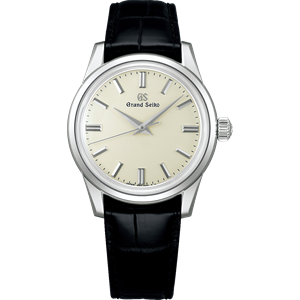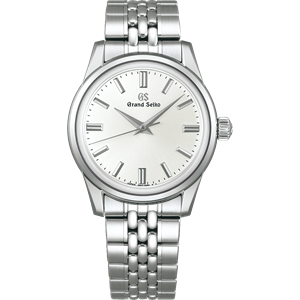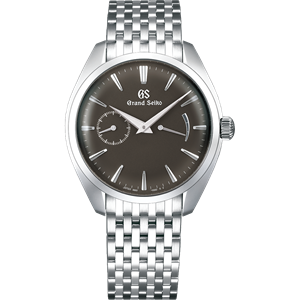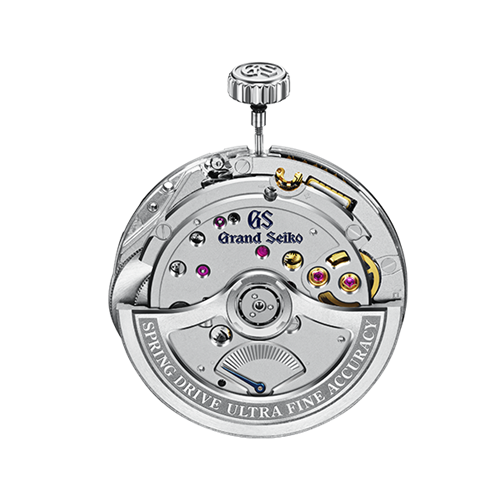
9S Mechanical
The concept of Grand Seiko was born from the desire to build the world's best watch, and the collection continues to push precision in mechanical watches to the limits of timekeeping technology.
As a true manufacture, Grand Seiko combines the latest technology with its long experience in craftsmanship to raise the art of watchmaking to new heights.
With anywhere between 200 and 300 individual components, mechanical watches must exhibit a near-perfect consistency in the detail of these parts to ensure the precision of the movement. High technology plays an important part in ensuring the level of performance required by the Grand Seiko Standard. For example, Grand Seiko employs Micro Electro Mechanical Systems (MEMS) in the manufacturing of its escapements, bringing to its mechanical watches a technology that was born in the development of semi-conductor manufacturing. Perfect components alone, however, cannot deliver the level of precision for which Grand Seiko is renowned. The task of assembling each Grand Seiko watch is carried out by craftsmen and women who have honed their craft to such an extent that they can adjust parts by hand to tolerances of one hundredth of a millimeter. It is the combination of high technology and this skilled craftsmanship that ensures the very precise timekeeping of each 9S mechanical movement.
Mechanism
Mechanical watches utilize an escapement, a self-contained device that draws its power from the motive force of a mainspring and also uses this power to regulate the speed at which the spring unwinds. It is a system which has remained largely unchanged since moving hands were first used to tell time.
A wound-up mainspring exerts force to turn gears at a set speed as it unwinds. The precision of the system as a whole is dictated by this speed and the escapement mechanism, comprising the balance, pallet fork, and escape wheel.
The pallet fork sets the pace for the revolving escape wheel and it, itself, operates in accordance with the oscillating balance.
The balance rotates back and forth like a pendulum, ensuring that the mainspring unwinds at an even speed over an extended period of time. In doing so, the balance effects the steady rotation of the hour, minute, and seconds hands.
Adjusting the hairspring – the key to precise timekeeping
The hairspring is the critical component at the heart of a mechanical watch as it governs its precision.
The elegantly coiled hairsprings are akin to living creatures, with individual characters all their own. Our craftsmen and women can identify and work with this variation, inserting pincers into the spaces within the coil to make adjustments by hand with a precision of one hundredth of a millimeter.
The beautiful ripple-like vibrations of a properly adjusted hairspring are enough to bring a smile to the face of any craftsman. To see the spring come alive is to witness the birth of a mechanical watch and is the moment when the watchmaker’s work transcends manufacturing to become a work of art.
The balance wheel
– a pillar of precision
The balance wheel is the component that ensures a consistent beat. This part is so critical to the overall precision of every Grand Seiko watch that its weight is adjusted to tolerances of one ten thousandth of a gram.
Because it is so sensitive, even the slightest temperature change can cause it to expand or contract, potentially leading to distortions in shape.
The 9S mechanical movement minimizes effects of temperature on the balance wheel and preserves overall precision by adding an additional arm over the usual two or three.
While this attention to detail increases the level of work required in the manufacture of the balance wheel, it is a vital to the maintenance of the highest possible levels of precision. Grand Seiko is committed to doing everything possible to ensure the perfect functioning of this all-important wheel.
Polished by hand
Power must flow between the gears with only minimal loss of energy to assure that the watch performs perfectly over time.
To ensure the efficient transfer of the power of the mainspring, Grand Seiko’s craftsmen and women polish the grooves between the gear teeth one by one.
This painstaking polishing of every gear tooth ensures that friction is minimized and that the longevity of every component is extended.
MEMS technology for high precision parts
Micro-Electro-Mechanical Systems (MEMS) technology is used to fabricate precision parts for Caliber 9S. MEMS, a highly advanced semi-conductor manufacturing technology, makes it possible to produce lightweight parts with extreme precision and to tolerances of one thousandth of a millimeter.
Quality control for the highest standard of accuracy
Precision beyond that of a chronometer
The first Grand Seiko born in 1960 carried the word 'Chronometer' on the dial to indicate its accuracy equivalent to the superior grade of the chronometer standard set by the Bureaux Officiels de Contrôle de la Marche des Montres of the time.
Today’s Grand Seiko watches, however, no longer carry this designation because, in 1966, Grand Seiko introduced its own, higher, standard. The latest version of this standard, the New GS Standard established in 1998, was more stringent than any other.
Some specially adjusted versions of Caliber 9S hold an even greater distinction. Designated with the ‘Grand Seiko Special Standard’, these movements have a precision rate of +4/-2 seconds a day.
A 17-day trial
Each 9S mechanical movement is assessed against a unique and rigorous set of standards over the course of 17 days. The movement is tested in six different positions and at three different temperatures, and its daily variations must fit within very strict tolerance rates in order to pass the test of the Grand Seiko Standard.
The pursuit of precision
Precision was the prime concern of the team that developed the first Grand Seiko in 1960. After meeting the chronometer standards of the time, Grand Seiko set its own accuracy standards in 1966. By 1998, advancements in materials and craft made possible a new, higher standard. To meet it, every movement undergoes rigorous testing in six positions and three temperatures over seventeen days.
The Grand Seiko Standard
| Item | Unit | Grand Seiko Special Standard | Grand Seiko Standard | Grand Seiko Standard for women |
|---|---|---|---|---|
| Mean daily rate* in six positions | Second / day | +4.0 ~ -2.0 | +5.0~ -3.0 | +8.0~ -3.0 |
| Mean variation of daily rate | Second / day | Less than 1.6 | Less than 1.8 | Less than 3.2 |
| Maximum daily rate between two consecutive daily rates in the same position | Second / day | Less than 3.0 | Less than 4.0 | Less than 6.0 |
| Variation of rate between positions horizontal and vertical | Second / day | +7.0 ~ -5.0 | +8.0 ~ -6.0 | +10.0 ~ -8.0 |
| Maximum daily rate between mean daily rate and any individual rate | Second / day | Less than 7.0 | Less than 8.0 | Less than 13.0 |
| Variation of daily rate per IC between 8℃ and 38℃ | Second / day / ℃ | +0.3 ~ -0.3 | +0.5 ~ -0.5 | +0.6 ~ -0.6 |
| Variation of daily rate per IC between 23℃ and 38℃ | Second / day / ℃ | +0.3 ~ -0.3 | +0.5 ~ -0.5 | +0.6 ~ -0.6 |
| Rate-resumption | Second / day | +4.0 ~ -4.0 | +5.0 ~ -5.0 | +6.0 ~ -6.0 |
| Number of positions in inspection | 6 positions | 6 positions | 6 positions | |
| Condition of temperatures in inspection | 8, 23, 38 ℃ | 8, 23, 38 ℃ | 8, 23, 38 ℃ | |
| Length of tests | 17 days | 17 days | 17 days |
Mean daily rate*: is a mean value of daily rates in a condition where the movement before assembly in a case is measured in 6 positions in a fixed manner under artificially controlled environment for 12 days.

History
Pursuing an ideal, since 1960.
From the very start, a precise perspective on time.
On December 18, 1960, the first Grand Seiko watch was unveiled. It expressed Grand Seiko’s commitment to the ultimate in precision, beauty and durability, ideals that still define Grand Seiko today.
9S Mechanical Movement
Movement Comparison
| Movement | Mean daily rate*1 | Normal usage accuracy | Power reserve | Vibrations | Number of jewels | Features |
|---|---|---|---|---|---|---|
| Manual-winding Mechanical Hi-Beat 36000 80 Hours Caliber 9SA4 (Manual winding mechanical) |
+5 to -3 seconds per day | +8 to -1 seconds per day | Approximately 80 hours | 36,000 vibrations per hour (10 beats per second) | 47 jewels | · Dual Impulse Escapement
· Twin barrels · Power reserve indicator |
| Hi-Beat 36000 3-Day Chronograph Caliber 9SC5 (Automatic with manual winding) |
+5 to -3 seconds per day | +8 to -1 seconds per day | Approximately 72 hours | 36,000 vibrations per hour (10 beats per second) | 60 jewels | -Chronograph
-Dual Impulse Escapement -Twin barrels |
| Hi-Beat 36000 80 Hours Caliber 9SA5 (Automatic with manual winding ) |
+5 to -3 seconds per day | +8 to -1 seconds per day | Approximately 80 hours | 36,000 vibrations per hour (10 beats per second) | 47 jewels | -Dual Impulse Escapement
-Twin barrels -Instant date change mechanism |
| Mechanical Hi-Beat 36000 GMT Caliber 9S86 (Automatic with manual winding mechanism) |
+5 to -3 seconds per day | +8 to -1 seconds per day | Approximately 55 hours | 36,000 vibrations per hour (10 beats per second) | 37 jewels | -Dual time function with 24-hour hand
-Quick correction function of time difference adjusting to a calendar |
| Mechanical Hi-Beat 36000 Caliber 9S85 (Automatic with manual winding mechanism) |
+5 to -3 seconds per day | +8 to -1 seconds per day | Approximately 55 hours | 36,000 vibrations per hour (10 beats per second) | 37 jewels | -Date display |
| Automatic 3-Day Power Reserve Caliber 9S68 (Automatic with manual winding mechanism) |
+5 to -3 seconds per day | +10 to -1 seconds per day | Approximately 72 hours | 28,800 vibrations per hour (8 beats per second) | 35 jewels | -Date display |
| Automatic 3-Day Power Reserve GMT Caliber 9S66 (Automatic with manual winding mechanism) |
+5 to -3 seconds per day | +10 to -1 seconds per day | Approximately 72 hours | 28,800 vibrations per hour (8 beats per second) | 35 jewels | -Dual time function with 24-hour hand
-Quick correction function of time difference adjusting to a calendar |
| Automatic 3-Day Power Reserve Caliber 9S65 (Automatic with manual winding mechanism) |
+5 to -3 seconds per day | +10 to -1 seconds per day | Approximately 72 hours | 28,800 vibrations per hour (8 beats per second) | 35 jewels | -Date display |
| Manual-winding Caliber 9S64 (Manual winding mechanical ) |
+5 to -3 seconds per day | +10 to -1 seconds per day | Approximately 72 hours | 28,800 vibrations per hour (8 beats per second) | 24 jewels | - |
| Manual-winding with a small seconds hand Caliber 9S63 (Manual winding mechanical ) |
+5 to -3 seconds per day | +10 to -1 seconds per day | Approximately 72 hours | 28,800 vibrations per hour (8 beats per second) | 33 jewels | -Power reserve indicator
-Small seconds hand |
| Small Size Automatic Caliber 9S27 (Automatic with manual winding mechanism) |
+8 to -3 seconds per day | +10 to -5 seconds per day | Approximately 50 hours | 28,800 vibrations per hour (8 beats per second) | 35 jewels | -Date display |
- Mean daily rate is a mean value of daily rates in a condition where the movement before assembly in a case is measured in six positions in a fixed manner under artificially controlled environment for 12 days.










.png)


































































































